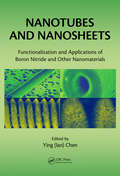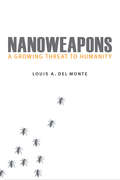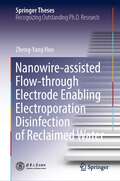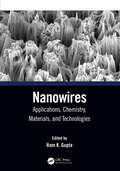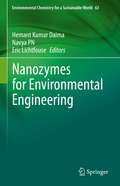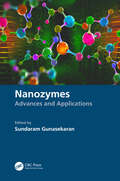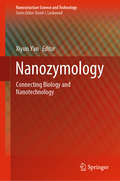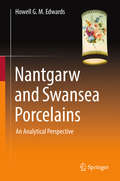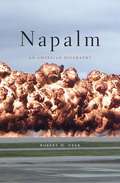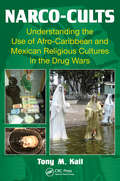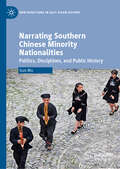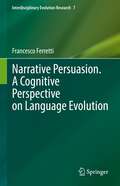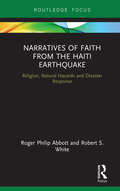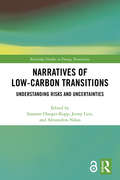- Table View
- List View
Nanotoxicology: Toxicity Evaluation, Risk Assessment and Management
by Vineet Kumar, Nandita Dasgupta and Shivendu RanjanAs the application of nanotechnology in the myriad disciplines of science and engineering--from agriculture, pharmaceuticals, material science, and biotechnology to sensors, electronics, and mechanical and electrical engineering--brings benefits it also can produce serious threats to human health and the environment that must be evaluated. The unique properties of nanomaterials make them different from their bulk counterparts. In addition to such unique properties, the nanometric size of nanomaterials can invite some detrimental effects on the health and well-being of living organisms and the environment. Thus, it is important to distinguish nanomaterials with such ill effects from nanomaterials with no or minimum toxicity. Nanotoxicology: Toxicity Evaluation, Risk Assessment and Management covers issues such as the basic principles of nanotoxicity, methods used for nanotoxicity evaluation, risk assessment and its management for nanomaterial toxicity with a focus on current trends, limitations, challenges, and future directions of nanotoxicity evaluation. Various experts from different countries discuss these issues in detail in this book. This will be helpful to researchers, educators, and students who are interested in research opportunities for avoiding the environmental and health hazards of nanomaterials. This book will also be useful for industrial practitioners, policy makers, and other professionals in the fields of toxicology, medicine, pharmacology, food, drugs, and other regulatory sciences.
Nanotribology and Nanomechanics I
by Bharat BhushanThe comprehensive reference and textbook serves as a timely, practical introduction to the principles of nanotribology and nanomechanics. Assuming some familiarity with macroscopic tribology, the book comprises chapters by internationally recognized experts, who integrate knowledge of the field from the mechanics and materials-science perspectives. They cover key measurement techniques, their applications, and theoretical modelling of interfaces, each beginning their contributions with macro- and progressing to microconcepts.
Nanotubes and Nanosheets: Functionalization and Applications of Boron Nitride and Other Nanomaterials
by Ying Ian ChenReveals Innovative Research on BN Nanotubes and NanosheetsNanotubes and Nanosheets: Functionalization and Applications of Boron Nitride and Other Nanomaterials is the first book devoted to nanotubes and nanosheets made of boron nitride (BN). It shows how the properties of BN nanotubes and nanosheets have led to many exciting applications where carb
Nanotubes and Nanosheets: The Science and Applications of White Graphene
by Ying Chen Srikanth Mateti Qiran CaiFocusing on the research and development of the renowned two-dimensional nanomaterial, white graphene, also known as boron nitride (BN) nanosheets, this book covers a comprehensive range of topics. These include the structures, production methods, properties, and exciting applications in energy storage, thermal management, and environmental solutions of nanotubes and nanosheets.Since the publication of the first edition, BN nanosheets have seen remarkable progress in research and application, leading to breakthroughs in discovering new properties, such as high modulus, thermal conductivity, and catalytic capabilities. Written by internationally acclaimed researchers with extensive expertise in BN nanomaterials, each chapter explores the unique properties of atomic-thin nanosheet structures and their surface chemistry. Later chapters highlight the diverse applications of BN nanosheets in areas including batteries, gas and oil adsorption and separation, and heat management. Readers will gain insights into the fundamental science behind this remarkable two-dimensional material, along with real-world applications in advanced batteries, heat dissipation, gas storage, and separation technologies.This well-structured arrangement aims to cater to a wide readership, attracting both university researchers in chemistry, materials science, and energy storage, and engineers from various industries. Additionally, this book serves as an invaluable reference for university students, offering an opportunity to explore new chemistry, novel material structures, and the immense potential of two-dimensional materials in addressing critical industrial challenges.
Nanovaccines: An Innovative Technology to Fight Human and Animal Diseases
by Sergio Rosales-Mendoza Omar González-OrtegaThis book provides a compilation of the current developments in mucosal nanovaccines, which are an attractive approach to fight against infectious and non-communicable diseases. Since nanomaterials possess unique properties; many of them have a positive effect on vaccine efficacy when used as antigen carriers and have been applied in vaccinology with significant advances over the past years. This book addresses the methodologies for mucosal nanovaccines synthesis; based on the following nanomaterials: gold, PLGA, silica, and chitosan nanoparticles; as well as nanogels, carbon nanotubes, liposomes, and Virus-like particles. A description of the immunogenic properties of the mucosal nanovaccines is presented, highlighting the improvements achieved with this approach when compared to conventional formulations. Mucosal vaccines constitute the most practical immunization approach since they are easy to administer (promoting patient´s comfort and increasing compliance), allow triggering relevant immune responses at both the site of administration and distant compartments, and thus may protect the main entry portal for pathogens (oral, nasal, and genital mucosae). In this context, the potential of nanovaccines to result in new mucosal formulations in the benefit of global health is analyzed. Covers the synthesis and functionalization of nanomaterials for the development of nanovaccines;Discusses the underlying mechanisms involved in the induction of immune responses through mucosal compartments and the advantages of nanomaterials in the formulation of nanovaccines;Transmits the state of the art for the development of mucosal nanovaccines;Provides routes for the design and evaluation of mucosal nanovaccines;Presents key perspectives for the field of mucosal vaccine development.
Nanovaccinology: Clinical Application of Nanostructured Materials Research to Translational Medicine
by Kaushik PalThis book provides an overview of the cumulative work on a driving force for innovation in medicine and modern healthcare, boosting advances in therapeutics, biosensors, vaccines, and clinical systems. The work presented shows how nanoparticles have been investigated as vaccine adjuvants because they possess chemical and structural properties that improve immunogenicity as well as the use of nanotechnology in the construction of immunization systems that has developed into the field of viral nanovaccinology. The volume highlights potential areas of research, innovation, and development of finished products for future commercialization and significant research exploration through nanoparticles that prove capable of surmounting most of the barriers like toxicity issues, clearance from biological system, DNA instability, and differences in expression systems. The contributing authors review the primary literature on principles, limitations, and recent breakthroughs in nanoparticle-based antigen delivery vehicles, their use in different diseases, the major bottlenecks, and related issues. Highlighting advances in nanoparticle engineering and the understanding of nanoparticle characteristics as well as critical legacy work dome in the field of nanobiotechnology, the book is ideal for a range of researchers and students in the pure and applied sciences devoted to nanomaterials, vaccinology, and translational medicine.
Nanoweapons: A Growing Threat to Humanity
by Louis A. Del MonteNanoweapons just might render humanity extinct in the near future—a notion that is frightening and shocking but potentially true. In Nanoweapons Louis A. Del Monte describes the most deadly generation of military weapons the world has ever encountered. With dimensions one-thousandth the diameter of a single strand of human hair, this technology threatens to eradicate humanity as it incites world governments to compete in the deadliest arms race ever. In his insightful and prescient account of this risky and radical technology, Del Monte predicts that nanoweapons will dominate the battlefield of the future and will help determine the superpowers of the twenty-first century. He traces the emergence of nanotechnology, discusses the current development of nanoweapons—such as the “mini-nuke,” which weighs five pounds and carries the power of one hundred tons of TNT—and offers concrete recommendations, founded in historical precedent, for controlling their proliferation and avoiding human annihilation. Most critically, Nanoweapons addresses the question: Will it be possible to develop, deploy, and use nanoweapons in warfare without rendering humanity extinct?
Nanowire Transistors
by Colinge, Jean-Pierre and Greer, James C. Jean-Pierre Colinge James C. GreerFrom quantum mechanical concepts to practical circuit applications, this book presents a self-contained and up-to-date account of the physics and technology of nanowire semiconductor devices. It includes a unified account of the critical ideas central to low-dimensional physics and transistor physics which equips readers with a common framework and language to accelerate scientific and technological developments across the two fields. Detailed descriptions of novel quantum mechanical effects such as quantum current oscillations, the metal-to-semiconductor transition and the transition from classical transistor to single-electron transistor operation are described in detail, in addition to real-world applications in the fields of nanoelectronics, biomedical sensing techniques, and advanced semiconductor research. Including numerous illustrations to help readers understand these phenomena, this is an essential resource for researchers and professional engineers working on semiconductor devices and materials in academia and industry.
Nanowire-assisted Flow-through Electrode Enabling Electroporation Disinfection of Reclaimed Water (Springer Theses)
by Zheng-Yang HuoThis Ph.D. book develops nanowire-assisted electroporation disinfection technology based on the flow-through porous electrode. The author presents pioneering results on theoretical modeling, experimental realization, and selected applications, showing the novel disinfection mechanism of electroporation guarantees an exceedingly low level of energy consumption. In this regard, three classes of novel dynamic behavior are investigated: (i) The developed nanowire-assisted flow-through electroporation disinfection technology enables great microbial disinfection performance with extremely low voltage (1V), which significantly reduce the formation potential of harmful disinfection by-products during the treatment process. (ii) The nanowire-assisted flow-through electroporation disinfection technology ensures no reactivation/regrowth of inactivated bacteria and meanwhile promotes the gradual death of damaged bacteria during the storage process. (iii) The application of high-frequency AC power supply (106 Hz) ensures the high microbial disinfection efficiency while suppressing the occurrence of electrochemical reactions and extending the electrode lifetime effectively.
Nanowires: Applications, Chemistry, Materials, and Technologies
by Ram K. GuptaThis comprehensive resource covers the fundamentals of synthesis, characterizations, recent progress, and applications of nanowires for many emerging applications. Early chapters address their unique properties and morphology that enable their electronic, optical, and mechanical properties to be tuned. Later chapters address future perspectives and future challenges in areas where nanowires could provide possible solutions. All chapters are written by global experts, making this a suitable textbook for students and an up-to-date handbook for researchers and industry professionals working in physics, chemistry, materials, energy, biomedical, and nanotechnology. Covers materials, chemistry, and technologies for nanowires. Covers the state-of-the-art progress and challenges in nanowires. Provides fundamentals of the electrochemical behavior of various electrochemical devices and sensors. Offers insights on tuning the properties of nanowires for many emerging applications. Provides a new direction and understanding to scientists, researchers, and students.
Nanozymes for Environmental Engineering (Environmental Chemistry for a Sustainable World #63)
by Eric Lichtfouse Hemant Kumar Daima Navya PnThis book reviews the latest developments and applications of nanozymes in environmental science. Protection of the environment is essential because pollution has become a global problem with many adverse effects on life and ecosystems. For that, remediation strategies and techniques have been designed, yet they are limited. Here, the recent development of nanotechnology opens a new vista for environmental remediation. In particular, nanomaterials displaying enzyme-like activities, named ‘nanozymes’, appear very promising for environmental monitoring, contaminant detection, microbial management, and degradation of organic pollutants. Nanomaterials including metallic, metal oxides and carbon-based nanoparticles with nanozymes activities have been synthesized. These nanozymes have similar activities as natural peroxidase, oxidase, superoxide dismutase and catalase enzymes. Nanozymes have several advantages, yet they suffer from several limitations such as low catalytic efficiency, less substrate selectivity, biocompatibility, and lack of engineering of the active sites.
Nanozymes in Medicine (Environmental Chemistry for a Sustainable World #72)
by Eric Lichtfouse Hemant Kumar Daima Navya PnThis book reviews the latest advances and biomedical applications of nanozymes, which are artificial nanomaterials exhibiting enzymatic properties similar to natural enzymes, but with less limitations than natural enzymes. Nanozymes display advantages such as facile synthesis, easy surface modification, improved stability, higher catalytic power, and target-specific binding. Nanozymes containing metals, metal oxides, carbon, and metal sulfide are actually used for cancer therapy, biomolecules sensing, bioimaging, disease diagnostics and diabetes management. The book discloses underlying mechanisms, concepts, recent trends, constraints, and prospects for nanomedicine using nanozymes.
Nanozymes: Advances and Applications
by Sundaram GunasekaranThis book presents the state-of-the-art advances and applications of nanozymes, the recently developing branch of enzymology that synthesizes and uses nanomaterials that mimic the function of traditional enzymes. During the past decade, the study of nanozymes has grown rapidly. Several new nanomaterials that exhibit enzymatic actions have been identified, along with new applications for their practical use. This book draws upon the work of experts from around the world and provides an in-depth analysis and cutting-edge overview of nanozymes, with an eye toward their present and future applications. Chapters are arranged in a logical order to provide physio-chemical characterization of nanozyme and basic mechanisms of their enzymatic actions. Focusing on current limitations of nanozymes and their reaction kinetics, the book presents a comprehensive discourse on nanozyme engineering that includes possible surface modifications to enhance nanozyme effectiveness. It also focuses on traditional and novel nanozyme applications, such as biosensing, drug delivery, and disease therapy, as well as their use as antibacterials. An important addition in this book is the summary of emerging literature on nanozyme toxicology. This book is intended as a ready reference for advanced undergraduate and graduate students doing research in nanotechnology; materials science; chemistry; and chemical, biological, biomedical, and food engineering. Research and development scientists, engineers, and technologists working in the chemical and biological/biomedical industries will gain much from the materials in this book for their industry practice. Presents a comprehensive discourse on nanozyme engineering that includes possible surface modifications to enhance nanozyme effectiveness. Discusses metal organic frameworks as nanozymes. Reviews on traditional and novel nanozyme applications, such as biosensing, drug delivery, disease therapy, and their use as antibacterials. Examines nanozyme toxicology. Dr. Sundaram Gunasekaran is a Professor in the Department of Biological Systems Engineering at the University of Wisconsin–Madison.
Nanozymology: Connecting Biology and Nanotechnology (Nanostructure Science and Technology)
by Xiyun YanThis book introduces the new concept of “nanozyme”, which refers to nanomaterials with intrinsic enzymatic activity, rather than nanomaterials with biological enzymes incorporated on the surface. The book presents the cutting-edge advances in nanozyme, with emphasis on state-of-the-art applications in many important fields, such as in the biomedical fields and for environmental protection. The nanozyme is a totally new type of artificial enzyme and exhibits huge advantages over natural enzymes, including greater stability, low cost, versatility, simplicity, and suitability for industry. It is of interest to university researchers, R&D engineers, as well as graduate students in nanoscience and technology, and biology wishing to learn the core principles, methods, and the corresponding applications of “nanozyme”.
Nantgarw and Swansea Porcelains: A Forensic Re-evaluation
by Howell G.M. EdwardsThis book gives a detailed account of the holistic research carried out on the analytical data obtained historically on the products of the Nantgarw and Swansea porcelain manufactories which existed for a few years only during the second decade of the 19th Century. A background to the establishment of the two factories, which are linked through the persons of the enigmatic William Billingsley and his kiln manager, Samuel Walker, involves the sourcing of their raw materials and problems associated with the manufacture and distribution of the finished products. A description of the minerals and additives used in porcelain production is recounted to set the scene for the critical evaluation of the comprehensive analytical data which have been published on Nantgarw and Swansea porcelains. For the first time, the author has adopted a nondestructive technique, Raman spectroscopy, to interrogate perfect samples of Nantgarw and Swansea porcelain, as well as a selection of shards from an archaeological excavation carried out at a waste dump at the Nantgarw China Works site. Following these experiments, several questions relating to the porcelain bodies of Swansea and Nantgarw china can be answered and a protocol established for the preliminary evaluation of items of suspect attribution to confirm or not the correctness of their assignment to these Welsh porcelain factories.
Napalm: An American Biography
by Robert M. NeerNapalm, incendiary gel that sticks to skin and burns to the bone, came into the world on Valentine's Day 1942 at a secret Harvard war research laboratory. On March 9, 1945, it created an inferno that killed over 87,500 people in Tokyo-more than died in the atomic explosions at Hiroshima or Nagasaki. It went on to incinerate sixty-four of Japan's largest cities. The Bomb got the press, but napalm did the work. After World War II, the incendiary held the line against communism in Greece and Korea-Napalm Day led the 1950 counter-attack from Inchon-and fought elsewhere under many flags. Americans generally applauded, until the Vietnam War. Today, napalm lives on as a pariah: a symbol of American cruelty and the misguided use of power, according to anti-war protesters in the 1960s and popular culture from Apocalypse Now to the punk band Napalm Death and British street artist Banksy. Its use by Serbia in 1994 and by the United States in Iraq in 2003 drew condemnation. United Nations delegates judged deployment against concentrations of civilians a war crime in 1980. After thirty-one years, America joined the global consensus, in 2011. Robert Neer has written the first history of napalm, from its inaugural test on the Harvard College soccer field, to a Marine Corps plan to attack Japan with millions of bats armed with tiny napalm time bombs, to the reflections of Phan Thi Kim Phuc, a girl who knew firsthand about its power and its morality.
Napoleon's Buttons
by Jay Burreson Penny Le CouteurNapoleon's Buttons is the fascinating account of seventeen groups of molecules that have greatly influenced the course of history. These molecules provided the impetus for early exploration, and made possible the voyages of discovery that ensued. The molecules resulted in grand feats of engineering and spurred advances in medicine and law; they determined what we now eat, drink, and wear. A change as small as the position of an atom can lead to enormous alterations in the properties of a substance-which, in turn, can result in great historical shifts. With lively prose and an eye for colorful and unusual details, Le Couteur and Burreson offer a novel way to understand the shaping of civilization and the workings of our contemporary world.
Narcissus and Daffodil: The Genus Narcissus (Medicinal And Aromatic Plants - Industrial Profiles Ser.)
by Gordon R. HanksNarcissus and Daffodil is the first book to provide a complete overview of the genus Narcissus. Prized for centuries in western Europe as an ornamental plant, it has recently attracted attention as a source of potentially valuable pharmaceuticals. In eastern European countries, however, Narcissus and other Amaryllidaceae have been valued as a sourc
Narco-Cults: Understanding the Use of Afro-Caribbean and Mexican Religious Cultures in the Drug Wars
by Tony M. KailThose who know about how spirituality plays into the world of drug smuggling have likely heard of Santa Muerte, Jesus Malverde, and Santer but the details of the more obscure African religions and Latin American folk saints and cults often remain a mystery. While the vast majority of these religions are practiced by law-abiding citizens with no co
Narcotics: Nature's Dangerous Gifts
by Norman TaylorInformation on marijuana, opium, morphine, heroin, coca, cocaine, alcohol, tobacco, ololiuqui, peyotl (mescaline), pituri, fly agaric, caapi, kava, betel, coffee, chocolate and tea.
Narrating Southern Chinese Minority Nationalities: Politics, Disciplines, and Public History (New Directions in East Asian History)
by Guo WuBased on fieldwork, archival research, and interviews, this book critically examines the building of modern Chinese discourse on a unified yet diverse Chinese nation on various sites of knowledge production. It argues that Chinese ideology on minority nationalities is rooted in modern China's quest for national integration and political authority. However, it also highlights the fact that the complex process of conceptualizing, investigating, classifying, curating, and writing minority history has been fraught with disputes and contradictions. As such, the book offers a timely contribution to the current debate in the fields of twentieth-century Chinese nationalism, minority policy, and anthropological practice.
Narrative Persuasion. A Cognitive Perspective on Language Evolution (Interdisciplinary Evolution Research #7)
by Francesco FerrettiThis book explores the evolutionary and cognitive foundations of human communication, focusing on narrative as its distinctive dimension. Within a framework of continuity with both the communication of our hominin predecessors and that of non-human animals, the book is about a twofold proposal. It includes the idea that (human and animal) communication has an intrinsically persuasive nature along with the hypothesis that humans developed narrative forms of communication in order to enhance their persuasive abilities. In this view, narrative persuasion becomes the feature that distinguishes human communication from animal communication. The study of the transition from animal communication to language addresses both the selective pressures that led communication for persuasive purposes to take a narrative form and the cognitive architectures and expressive systems that enabled our ancestors to cope with the selective pressures of persuasive/narrative-based communication. Language evolution is interdisciplinary, even from the specific perspective of evolutionary pragmatics chosen here. Therefore, this book is intended for researchers working in fields such as cognitive sciences, philosophy, evolutionary biology, cognitive psychology, and primatology. It also represents a valuable resource for advanced students in cognitive sciences, linguistics, and philosophy.
Narratives of Faith from the Haiti Earthquake: Religion, Natural Hazards and Disaster Response (Routledge Focus on Religion)
by Roger Philip Abbott Robert S. WhiteThis book presents an in-depth ethnographic case study carried out in the years following the 2010 Haiti earthquake to present the role of faith beliefs in disaster response. The earthquake is one of the most destructive on record, and the aftermath, including a cholera epidemic and ongoing humanitarian aid, has continued for years following the catastrophe. Based on dozens of interviews, this book gives primacy to survivors’ narratives. It begins by laying out the Haitian context, before presenting an account of the earthquake from survivors’ perspectives. It then explores in detail how the earthquake affected the religious, mainly Christian, faith of survivors and how religious faith influenced how they responded to, and are recovering from, the experience. The account is also informed by geoscience and the accompanying "complicating factors." Finally, the Haitian experience highlights the significant role that religious faith can play alongside other learned coping strategies in disaster response and recovery globally. This book contributes an important case study to an emerging literature in which the influence of both religion and narrative is being recognised. It will be of interest to scholars of any discipline concerned with disaster response, including practical theology, anthropology, psychology, geography, Caribbean studies and earth science. It will also provide a resource for non-governmental organisations.
Narratives of Low-Carbon Transitions: Understanding Risks and Uncertainties (Routledge Studies in Energy Transitions)
by Jenny Lieu Susanne Hanger-Kopp Alexandros Nikas"The Open Access version of this book, available at https://doi.org/10.4324/9780429458781, has been made available under a Creative Commons Attribution-Non Commercial-No Derivatives 4.0 license." This book examines the uncertainties underlying various strategies for a low-carbon future. Most prominently, such strategies relate to transitions in the energy sector, on both the supply and the demand side. At the same time they interact with other sectors, such as industrial production, transport, and building, and ultimately require new behaviour patterns at household and individual levels. Currently, much research is available on the effectiveness of these strategies but, in order to successfully implement comprehensive transition pathways, it is crucial not only to understand the benefits but also the risks. Filling this gap, this volume provides an interdisciplinary, conceptual framework to assess risks and uncertainties associated with low-carbon policies and applies this consistently across 11 country cases from around the world, illustrating alternative transition pathways in various contexts. The cases are presented as narratives, drawing on stakeholder-driven research efforts. They showcase diverse empirical evidence reflecting the complex challenges to and potential negative consequences of such pathways. Together, they enable the reader to draw valuable lessons on the risks and uncertainties associated with choosing the envisaged transition pathways, as well as ways to manage the implementation of these pathways and ultimately enable sustainable and lasting social and environmental effects. This book will be of great interest to students, scholars, and practitioners of environmental and energy policy, low-carbon transitions, renewable energy technologies, climate change action, and sustainability in general.
Narrow Gap Semiconductors 1995: Proceedings of the Seventh International Conference on Narrow Gap Semiconductors, Santa Fe, New Mexico, 8-12 January 1995 (Institute Of Physics Conference Ser. #144)
by J L RenoNarrow Gap Semiconductors 1995 contains the invited and contributed papers presented at the Seventh International Conference on Narrow Gap Semiconductors, held in January 1995. The invited review papers provide an overview and the contributed papers provide in-depth coverage of research results across the whole field.


